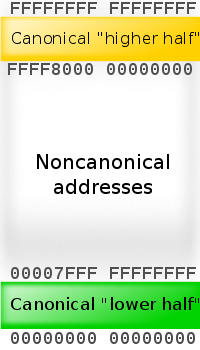In a 64-bit os, the maximum memory space for a single process is 2^48 bits. (More is theoretically possible, but no chipset on the market actually decodes more than 48 bits of address.)
Canonical form addresses
Although virtual addresses are 64 bits wide in 64-bit mode, current implementations (and all chips known to be in the planning stages) do not allow the entire virtual address space of 264 bytes (16 EB) to be used. Most operating systems and applications will not need such a large address space for the foreseeable future (for example, Windows implementations for AMD64 are only populating 16 TB, or 44 bits' worth), so implementing such wide virtual addresses would simply increase the complexity and cost of address translation with no real benefit. AMD therefore decided that, in the first implementations of the architecture, only the least significant 48 bits of a virtual address would actually be used in address translation (page table lookup).[1](p120) Further, bits 48 through 63 of any virtual address must be copies of bit 47 (in a manner akin to sign extension), or the processor will raise an exception.[1](p131) Addresses complying with this rule are referred to as "canonical form."[1](p130) Canonical form addresses run from 0 through 00007FFF'FFFFFFFF, and from FFFF8000'00000000 through FFFFFFFF'FFFFFFFF, for a total of 256 TB of usable virtual address space.
This "quirk" allows an important feature for later scalability to true 64-bit addressing: many operating systems (including, but not limited to, the Windows NT family) take the higher-addressed half of the address space (named kernel space) for themselves and leave the lower-addressed half (user space) for application code, user mode stacks, heaps, and other data regions. The "canonical address" design ensures that every AMD64 compliant implementation has, in effect, two memory halves: the lower half starts at 00000000'00000000 and "grows upwards" as more virtual address bits become available, while the higher half is "docked" to the top of the address space and grows downwards. Also, fixing the contents of the unused address bits prevents their use by operating system as flags, privilege markers, etc., as such use could become problematic when the architecture is extended to implement more bits of virtual addresses.
| Current 48-bit implementation | 56-bit implementation | Full 64-bit implementation |





 本文介绍了64位操作系统中虚拟地址空间的设计限制及其原因。尽管理论上支持2^64字节的地址空间,但当前实现仅使用48位地址,并采用规范形式地址来确保系统的可扩展性和兼容性。
本文介绍了64位操作系统中虚拟地址空间的设计限制及其原因。尽管理论上支持2^64字节的地址空间,但当前实现仅使用48位地址,并采用规范形式地址来确保系统的可扩展性和兼容性。




















 被折叠的 条评论
为什么被折叠?
被折叠的 条评论
为什么被折叠?








